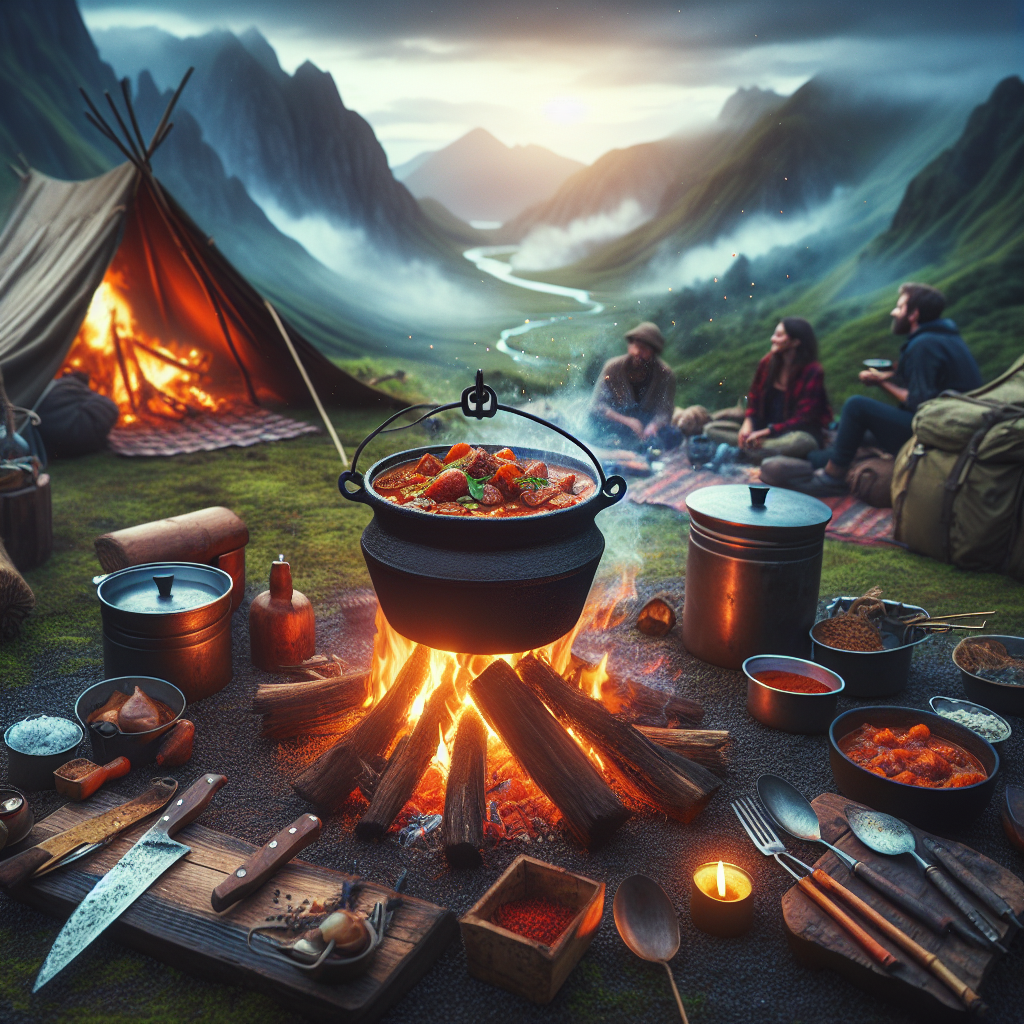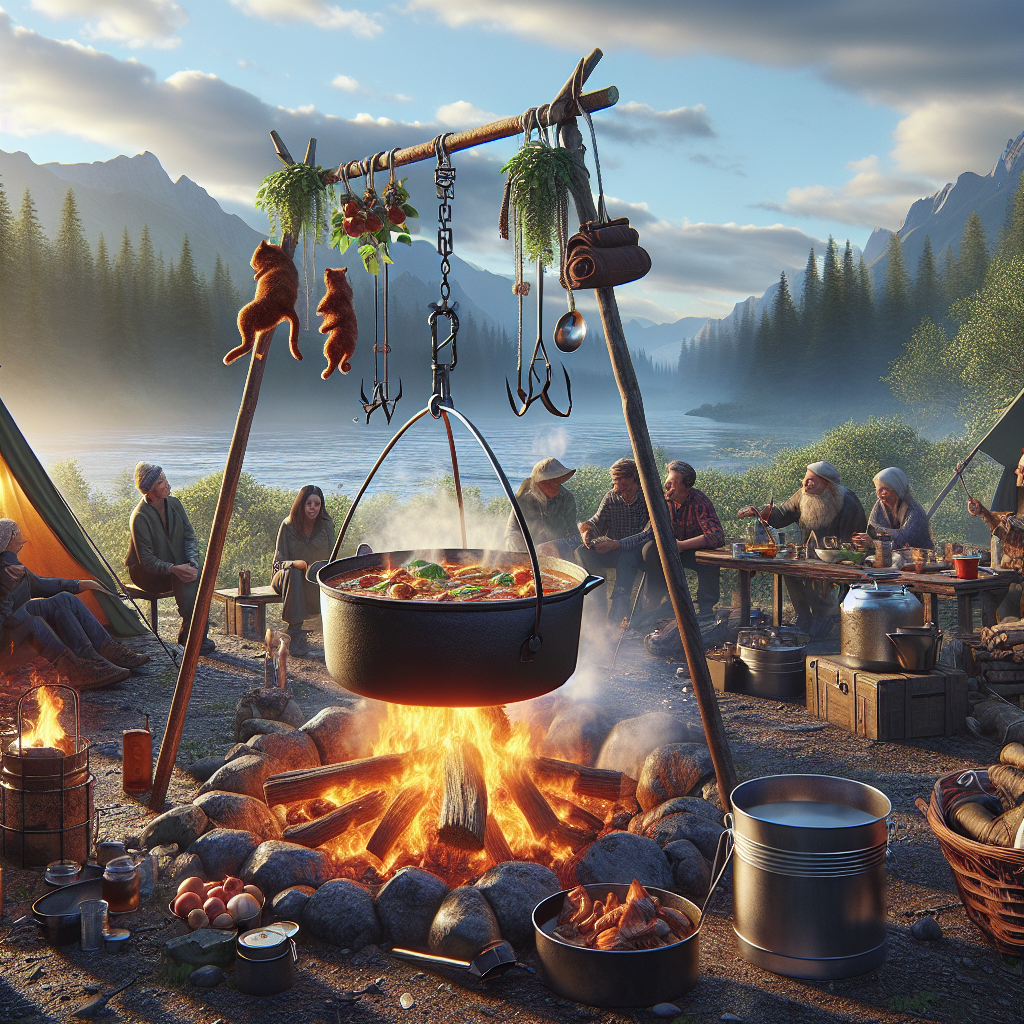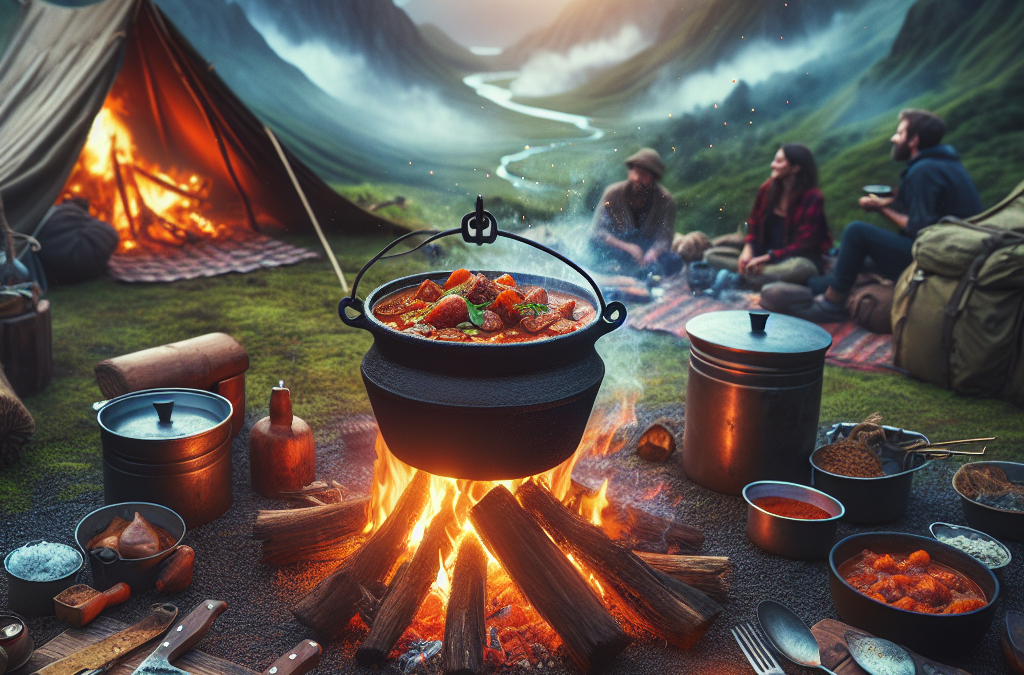Imagine yourself on a camping trip, under the blanket of stars with your loved ones, enjoying the warm of the glowing embers. In this context, “campfire Cooking: Delicious Recipes and Safety Tips” comes as the perfect guide. Here you’ll unlock secrets to concocting mouth-watering meals over a campfire, while maintaining utmost safety. Not just the traditional toasted marshmallows or hot dogs, but creative, hearty dishes that can be savored amidst the serenity of nature. With this guide, you’ll not only cherish the fun and fellowship of camping but also become a pro at curating memorable camping meals!
Understanding Campfire Cooking
There’s something enchanting about the crackling flames, the aroma of food cooking on an open fire, the camaraderie in the camp, and of course the great outdoors. This, in essence, is what campfire cooking is all about.
The concept of campfire cooking
Campfire cooking is an activity that takes you back to the basics, where the natural conditions become a part of your culinary adventure. It involves preparing meals over an open flame, utilizing the heat generated by the campfire to roast, grill, or even smoke the food. It requires creativity, patience, and a unique type of culinary ability. Hence, campfire cooking is not just about the food, but it’s also about the experience, the ambiance, and the joy of outdoor cooking.
The history and tradition of cooking on an open fire
The origin of campfire cooking goes back thousands of years, even before the advent of modern culinary tools. It was the primary means of cooking for our hunter-gatherer ancestors. Later on, it became a tradition for explorers, settlers, soldiers, and pioneers as they traversed continents and endured harsh conditions. Even today, in many parts of the world, including the rural parts of Africa, Asia, and South America, open fire cooking is still the main method of preparing meals.
Importance of campfire cooking in outdoor adventures
Campfire cooking can enhance your outdoor experience by engaging you completely in the process – from gathering the wood or twigs, building the fire, preparing the ingredients, to finally serving up a well-deserved meal. It’s about immersing yourself in the wilderness, being one with nature, and making the most out of what is available around you.
The Tools You Need For Campfire Cooking
Knowing your tools is an essential part of campfire cooking. The tools help you control the process and ensure that you cook your meals to perfection.
The importance of proper tools
Having the right equipment is significant because it not only aids in convenient cooking but also ensures your safety and the durability of the cooking ware. Heavy-duty, long-handled utensils, for instance, will keep you at a safe distance from fire while withstanding the sprightly heat of the campfire.
Basic tools for campfire cooking
The most simple tools for campfire cooking include a sturdy, heavy-duty pot or pan, long-handled spatulas or tongs, skewers for grilling, a knife for preparing ingredients, and so on. A pair of good-quality oven mitts or pot grippers is also a must-have to handle hot vessels and prevent burns.
Advanced tools for the professional outdoor chef
For the ones who take campfire cooking beyond basics, there are advanced tools, like grates and grills, tripod stands, smoker boxes, and Dutch ovens. Using them properly can lead to the creation of a diverse range of dishes that not only taste good but also have the distinct flavor that only open-fire cooking can provide.
Maintenance and care for your cooking tools
Take care of your tools, and they’ll take care of you. Cleaning them thoroughly after each use, applying a bit of oil to prevent rust, and storing them in a dry place will ensure they serve you longer. Also, respect the capabilities and limitations of your tools, don’t push them beyond their threshold –for example, never use a non-stick pan on an open fire.

Setting Up Your Campfire Properly
Before the actual cooking, setting up a well-structured campfire is crucial. Location, orientation, and the type of fire setup will directly impact your cooking process.
Selecting the right spot for your campfire
Choose a spot which is away from trees, shrubs, and anything that can catch fire unintentionally. The place should also be oriented to the prevailing wind direction to channel smoke away from your cooking and seating area.
Basic steps in setting up a campfire
To set up a good campfire, first, clear the fire spot of any grass, twigs, or flammable material to create a dirt patch. Stack the materials in the shape of a pyramid, teepee or log cabin. Start with small pieces of wood or tinder, then graduate to larger logs or fuelwood. Ensure you have a good supply of wood to keep the fire going.
The importance of a well-prepared campfire in cooking
Having a well-prepared campfire allows for more control over your cooking process, ensuring a steady heat source and reducing the risk of unexpected flare-ups that might char your food or put you in danger.
Wind direction and placement of fire
Knowing the wind direction before setting your campfire is vital as it directly impacts the fire’s behavior and consequently, your cooking. Wind can blow embers around, causing safety issues, and uneven heat dispersion that might result in undercooked food. Position your campfire such that the wind direction guides the smoke away from your seating or cooking area, making your culinary session an enjoyable and hassle-free experience.
Safety Precautions In Campfire Cooking
Safety should be at the forefront of any campfire cooking endeavor. Fires, if not handled correctly, can be hazardous, and you must always exercise caution when cooking in the wild.
Importance of safety in campfire cooking
Given that you’re dealing with open fire, the potential risks of injury are higher in campfire cooking. So, prioritizing safety not only prevents accidents but also makes the entire process more enjoyable and less stressful.
Safe handling of cooking tools
Always use long-handled utensils to keep a safe distance from the fire, and make sure to use gloves or mittens when handling hot pots and pans. Remember, metal handles can also get hot, so always approach with caution.
Fire safety tips
Keep a fire extinguisher or a bucket of water or sand nearby to put out any potential fire hazards immediately. Also, avoid wearing loose-fitting clothes, especially those with flowing sleeves, to prevent them from catching fire.
Handling leftovers and food safety
Leftover food should be carefully stored away in sealed containers to prevent them from attracting wildlife to the campsite. Pay extra attention to cleanliness to prevent food contamination, especially in a wilderness environment where hygiene can be a little challenging.

Building and Maintaining Your Fire
Building a strong and long-lasting fire is the basis for a successful campfire cooking experience. It’s all about controlling the flame and maintaining the right temperature for your cooking.
How to create a strong and lasting fire for cooking
Start small by using dry twigs or newspapers, then gradually add larger pieces of wood. This ensures the fire has a chance to grow steadily and get strong. Use hardwoods like oak or maple as they burn longer and hotter than softwoods.
Maintaining the correct temperature for cooking
Achieving the right temperature depends on the type of food you are cooking. For a simmer, you will need a small flame, while for searing or grilling, intense heat is required. The key lies in managing the size of your fire and the quantity of the burning material. Remember, controlling the heat in campfire cooking comes with experience and practice.
Adding fuel to your fire safely
When adding fuel to your fire, be careful not to disturb the existing structure. Place the new wood gently on the fire or to its side so that it can catch fire gradually. Also, generally, it’s safer to use sticks and logs as fuel rather than liquid accelerants.
Putting out your fire: safety and environmental considerations
Extinguishing your campfire properly is vital for both safety and environmental reasons. Cover the fire with sand or water to quench the flames completely. Make sure no glowing embers are left. Respect the wilderness and dispose of the ashes in a manner that does not harm the environment.
Easy Recipes For Campfire Cooking
Time to put those campfire cooking skills to work! Let’s try out some easy recipes for your next camping trip.
Classic campfire meals: an overview
Classic campfire meals usually consist of easy-to-prepare dishes like grilled meats, skewered vegetables, roasted corn, or marshmallows. They require minimal prep time, and the rustic campfire adds a lovely smoky flavor to them.
Preparing and cooking campfire soup
A quick Campfire Soup can provide much-needed warmth on a chilly night. Start with sautéing onions and garlic in a pot. Add your choice of chopped veggies, cooked meat, canned beans, and broth. Let the soup simmer on the fire until everything is well cooked. A piece of crusty bread will pair excellently with this hearty soup.
Creating mouth-watering campfire skewers
Campfire skewers are simple and fun to make. Marinate pieces of chicken, beef, or vegetables, thread them onto skewers, and place them over the fire. Keep turning the skewers so that they get evenly cooked.
Desserts: Sweet treats you can make on a campfire
Who says you can’t enjoy desserts in the wilderness? Try roasting marshmallows for a classic camping dessert or wrap sliced fruits with cinnamon-sugar in foil and place it in the coals for a sweet and healthy treat.
Advanced Recipes For Campfire Cooking
If you wish to take your campfire cooking up a notch, here are some gourmet recipes that can be prepared on an open fire.
Culinary delights: Gourmet recipes on open fire
Think along the lines of Roasted Salmon with Lemon and Dill, or a Grilled Leg of Lamb with Rosemary and Garlic. These dishes require more preparation and delicate handling of the fire, but the result is nothing short of exquisite.
Preparation tips for advanced campfire meals
When it comes to advanced recipes, attention to detail is the key. Prepare whatever you can in advance and focus on maintaining a steady temperature during cooking.
Cooking with dutch ovens: A taste of home in the outdoors
Dutch ovens are great for making versatile dishes, from stews and roasts to even baking bread and cakes! They’re sturdy and they retain heat well, giving all ingredients a chance to cook evenly.
Fish and seafood recipes for a hearty meal
Almost any seafood dish you can make at home can be made on a campfire — with a little creativity and a good fire. Whole grilled fish, seafood paella, skewered shrimp – take your pick!
Vegan And Vegetarian Dishes For Campfire Cooking
You don’t have to be a meat-lover to enjoy campfire cooking. There are many delicious plant-based recipes that taste phenomenal when cooked over a campfire.
Appetizing vegan and vegetarian options
From grilled vegetables, tofu skewers, and veggie wraps, to hearty vegan chili or lentil soups – there’s no shortage of healthy, plant-based options for vegan campfire cooking.
Turning classic campfire meals into plant-based delights
You can easily swap the meat in traditional campfire meals with plant-based proteins like beans, lentils, tofu, or tempeh. And remember, a generous sprinkle of spices can elevate even the simplest of vegan dishes.
Getting creative with fruits and vegetables
Try using fruits and vegetables in unusual ways – like grilling peaches or watermelons, or using hollowed-out bell peppers or pumpkin halves as bowls for individual, campfire-baked stews and soups.
Cleanup And Leaving No Trace
Just as starting a fire is an essential part of campfire cooking, properly extinguishing it and cleaning up the area is equally important.
The principle of Leave No Trace in campfire cooking
Don’t leave any garbage, food remnants or signs of your fire after you pack up to leave. This principle is not only respectful to other campers but also crucial for preserving the natural surroundings.
Keeping your cooking area clean
Keep your cooking area tidy throughout the cooking process. A clean area not only makes cooking more manageable, but it is also a crucial safety measure to keep insects and wildlife at bay.
Disposing of food waste responsibly
Food waste should never be left scattered around your site or burned in the campfire. Instead, seal it properly and take it back with you for correct disposal.
Correctly extinguishing a fire and cleanup
Never leave a fire unattended, and completely extinguish it before leaving your campsite. Stir the ashes while pouring water to ensure the fire is out. Finally, return the area to how you found it – or better.
Expert Tips and Tricks For Campfire Cooking
Let’s seal our campfire culinary guide with some tips and tricks straight from experienced campfire chefs.
Top tips from seasoned outdoor chefs
More flame isn’t always better, a cooking fire needs a bed of hot coals more than actual flames. Also, prepping as much as possible before leaving home can make the campfire cooking process smoother and more enjoyable.
Common mistakes to avoid in campfire cooking
Not using a fireproof base, like a fire ring or a bed of gravel or sand under your fire, is a common mistake. Rushing the cooking process is another error that often leads to unappetizing results.
Care for your cooking tools for longevity
Keeping your tools clean and properly stored ensures they last longer and perform better. Regularly oiling the cookware also prevents rusting and degradation.
Challenges in campfire cooking and how to overcome them
Campfire cooking comes with unique challenges, like dealing with unexpected weather changes or stray wildlife. To overcome these, preparation is key. Having wet weather contingency plans and keeping food and scraps stored securely can help mitigate these issues.
With all these tips and pointers in mind, you are now ready to embrace the joy of campfire cooking. Remember, it’s not just about the meal but the whole experience – being surrounded by nature, camaraderie, and the warm glow from the campfire – that creates cherished memories and delicious dishes! Happy camping and cooking!

